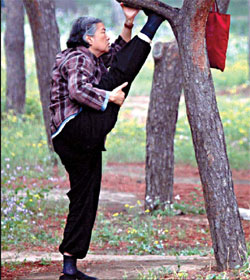Doctor Ajandok Eory once again has organized Hungarian medical practitioners to come to Beijing to learn the 312 exercise, a meridian-based fitness program.
It was the seventh visit of his fellow countrymen during the past decade. The Hungarian, now serving as the president of Hungarian Society of Acupuncture and Moxibustion, has a strong faith in Traditional Chinese Medicine (TCM) and especially its core concept of meridian theory.
He was the organizer of the first International Meridian Conference in 1985 and also the first discoverer of plant meridian through applying thermograph.
He has known Dr Zhu Zongxiang, the inventor of the exercise, for more than two decades, and believes the simple exercise incorporates the essence of TCM and greatly benefit his people.
However, he admitted that in Western countries, it was more difficult for people to accept such a foreign idea.
He especially targeted poor people, who would benefit most from the exercise. "Western medicine is growing to be more and more expensive. As medical practitioners, we have to give something to poor people to enhance their health level. It should be cheap with no side effects," he said.
In Hungary, he organizes medical volunteers to go onto the streets to provide free blood-pressure measurement services for passers-by. If a person's blood pressure is high, the volunteers suggest the 312 exercise. Hundreds of new patients are joining the exercise group.
 |
A woman exercises in the park surrounding the Temple of Heaven in Beijing. Daily exercises for 25 minutes will keep people healthy and vigorous, according to doctor Zhu Zongxiang.
Comparatively, in Southeast Asian countries, such as Malaysia and Singapore, the scope of 312 exercises is much more extensive. In Singapore there are 80,000 registered practitioners and in Malaysia there are 160,000.
Zhu credited Huang Yucheng, a Chinese Malaysian businessman, for its rapid expansion.
Huang owned an electronics company and as his business was flourishing in 1989, he suddenly felt stomach pains. He was later diagnosed with urinary calculus and gouty arthritis. At first he relied on drugs to relieve the pain, but years later, he gradually developed resistance to the drugs and his physical condition worsened everyday.
Huang decided to blaze another trail to regain health. He practiced Tai Chi and tried all kinds of TCM. Later, and by accident, he received a disk of 312 meridian exercises from a friend and followed the instructions by the teacher in the video.
One year later his pain went away and he gradually regained his strength and vigor.
In the 1990s, according to Huang, there were hundreds of thousands of disks of 312 meridian exercises spreading in Southeast Asia. However, few people really recognized its health care value.
In 2004, with gratitude and a little curiosity, he came to Beijing and met with the exercise's inventor, Zhu, who encouraged him to popularize the exercise to more Singaporeans.
Later, Huang quit his own company business and devoted himself to building a network of meridian exercise centers, including fitness centers and hospitals.
In his eyes, 312 exercises is not an exercise only for old people and he has already introduced it into primary schools.
沒有留言:
張貼留言